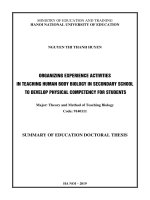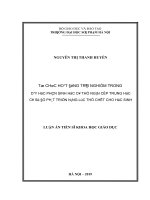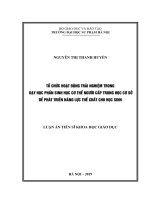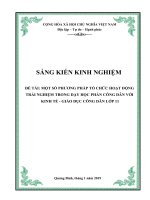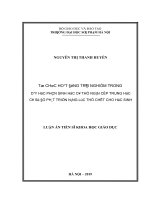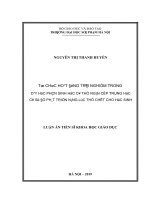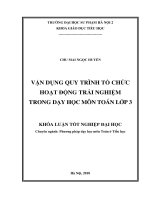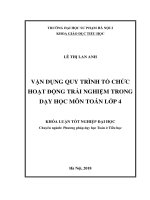Tổ chức hoạt động trải nghiệm trong dạy học phần sinh học cơ thể người cấp THCS để phát triển năng lực thể chất cho học sinh tt tiếng anh
Bạn đang xem bản rút gọn của tài liệu. Xem và tải ngay bản đầy đủ của tài liệu tại đây (734.45 KB, 27 trang )
MINISTRY OF EDUCATION AND TRAINING
HANOI NATIONAL UNIVERSITY OF EDUCATION
NGUYEN THI THANH HUYEN
ORGANIZING EXPERIENCE ACTIVITIES
IN TEACHING HUMAN BODY BIOLOGY IN SECONDARY SCHOOL
TO DEVELOP PHYSICAL COMPETENCY FOR STUDENTS
Major: Theory and Method of Teaching Biology
Code: 9140111
SUMMARY OF EDUCATION DOCTORAL THESIS
HA NOI – 2019
THIS WORK WAS COMPLETED AT HANOI
NATIONAL UNIVERSITY OF EDUCATION
Scientific Instructors
1. Prof. Dr. DINH QUANG BAO
2. Dr. NGUYEN THI BICH NGOC
Criticizer 1: Assoc Prof – Dr. NGUYEN VAN HONG
Thai Nguyen University of Education
Criticizer 2: Assoc Prof – Dr. NGUYEN DINH NHAM
Vinh University of Education
Criticizer 3: Dr. NGO VAN HUNG
Ha noi Metropolian University
The thesis is defended under School level thesis scoring board
at Ha Noi National University of Education
at …. hour…… day….. month……. year 2019
The thesis can be referred at:
1. National Library of Vietnam
2. Library of Ha Noi National University of Education
LIST OF PUBLISHED WORKS RELATING TO THIS THESIS
1.
Nguyen Thi Thanh Huyen, Nguyen Thi Bich Ngoc (2018). The stucture of
Physical competency as well as its application in teaching human body biology
in secondary school, Vietnam Journal of science Education, No 10, pp.77-82.
2.
Nguyen Thi Thanh Huyen (2018). Reality about the organization of experience
activities to develop Physical competency for students in teaching human body
biology in secondary school, Vietnam Journal of Education, No 443, pp.54-58.
3.
Nguyen Thi Thanh Huyen, Dinh Quang Bao (2018). Developing physical
competency for students through experiential activities in teaching human biology
at secondary level, Vietnam Journal of Education, Vol. 4, 2018, pp. 53-57.
4.
Nguyen Thi Thanh Huyen (2019). Building experience activities in teaching
Human Biology to develop physical competency for students, Vietnam Journal
of Education, No 453, pp.54-58.
1
INTRODUCTION
1. RATIONALE
The issue of education innovation has been included in the Resolution of the
IX, X, XI Party Congresses and institutionalized by the Education Essay. However, at
present, in secondary schools, teachers are too focused on the transmission of
knowledge, and are not really interested in teaching students to form and develop
special skills, especially Physical competency. Physical competency is taught by
physical education as equipped with health knowledge, select appropriate forms of
self-exercise to practice; adapt to living conditions, optimistic and share with people;
having a healthy physical and mental life and this energy is very convenient to be
trained in teaching Human body biology in secondary school by organizing
Experimental Activities From the above reasons, we choose the topic: "Organizing
experience activities in teaching Human body biology in secondary school to
develop Physical competency for students" to study.
2. AIMS OF THE STUDY
Study theoretical basis of physical capacity, physical education and experiential
learning model, build experience activities to teach human body biology and integrate
training, capacity development Physical for middle school students
3. 3. SUBJECTS AND RESEARCH OBJECTS
3.1. Research subjects Organize the teaching of human body biology by experiencing
and integrating physical competency education for students.
3.2. Object of research: The process of teaching human body biology at the middle
school level
4. THEORY OF SCIENCE
If a Physical competency structure is successfully built and teaching process of
human body biology by an Organizing experience activities and the integration of
physical competency education, the student will both acquire the knowledge of
human body biology and developed physical competency
5. SCIENTIFIC RESEARCH TASK
5.1. Studying the theoretical and practical basis of experience activities to teach
Physical competency for students.
5.2. Analyzing human body biology's content and objectives to organize
experience activities for students.
5.3. Determining the structure of Physical competency and building the
process of organizing experience activities to educate Physical competency for
secondary school students; develop procedures and measurements for evaluating
Physical competency of secondary school students
5.4. Pedagogical experiment is carried out to verify the scientific hypothesis of
the topic
2
6. METHOD OF THE STUDY
6.1. Method of theoretical research
6.2. Basic investigation method
6.3. Expert consultation method
6.4. Experimental method of pedagogy
6.5. Data processing by mathematical statistics
7. SCOPE OF THE STUDY
7.1. Limit research content
Building experiential activities to teach in teaching Human body biology follow
David Kolb model to integrate physical education in 5 chapters of the first semester
of the Human Biology and Hygiene (Biology 8) section
7.2 Limit the study area
The project was studied at 6 secondary schools in 3 cities / provinces: Ha
Noi, Hai Dương, Phu Tho.
8. NEW CONTRIBUTION OF THE THESIS
8.1. Contribute to perfecting the theoretical and practical basis of organization
experience activities to develop the Physical competency for secondary school
students through teaching human body biology - biology 8. Clarifying the theoretical
basis of Physical competency in teaching human body biology.
8.2. The structure of Physical competency and the process of organizing
experience activities in teaching human body biology to form and develop the
financial capability for grade 8 students.
8.3. Constructing experience activities to develop Physical competency for
students in teaching human body biology at secondary school. constructing
experience activities educate Physical competency for students in grade 8.
8.4. The set of criteria for assessing each level of proficiency of each skill of
Physical competency and the set of measurements to evaluate the Physical
competency of students through teaching human body biology by experience
activities.
8.3. Proposing the process of designing experience activities to integrate
human body biology, forming and developing physical capacity for students.
8.4. Identify the process of organizing experience activities to develop physical
capacity for grade 8 students.
8.5. Develop a set of criteria and tools for assessing physical capacity of grade
8 students.
9. THESIS STRUCTURE
In addition to the introduction, conclusions and recommendations, references,
appendices, research works. The thesis consists of 3 chapters: chapter 1. The
theoretical and practical basis of the thesis; chapter 2. The organization of experience
activities in teaching human body biology at secondary school to develop Physical
competency for students; chapter 3. Pedagogical experiment.
3
RESEARCH RESULTS
CHAPTER 1
THEORETICAL BASIS AND PRACTICE OF THE THESIS
1.1. HISTORICAL RESEARCH ON PHYSICAL COMPETENCY
AND
EXPERIMENTAL ACTIVITIES
Physical competency is educated through the content of physical education In each
country, the contents of physical education designed and taught for students are different.
In some countries like ghana and south africa physical education for students isn't got any
attention, some countries such as china, greece, slovenia ... Emphasize that education for
students focuses on good motor skills/manipulation the ability to exercise without paying
attention to educate students on the awareness of the human body so that it can reveal
behaviors and habits that are conducive to health. In countries such as singapore, laos and
france ... In addition to educating students on motor skills, the program has integrated
knowledge and skills to the physical and mental health care for students. Researchers in
Physical competency in vietnam go deep into researching the education of Physical
competency by not doing research on Physical competency education awareness.
Teaching through experience activities has been of interest to many educational
researchers around the world. Although there are many different approaches, there is a
common point of view: teaching by organizing the experience activities will help learners
attach theory to practice; through the experience activities will help learners be more
dynamic and creative while also showing the building of a collaborative environment,
bringing learners into the experience activities, sharing their experiences in the teaching
process has been a problem and an interest in theoretical and practical research. The
research works have been tested on a wide range of different age groups but none of them
have been fully studied, the system of processes and measures to organize experience
activities and develop the Physical competency for secondary school students.
1.2. RATIONALE
1.2.1. Physical, Physical development, Physical education
General education program (2018): “Physicality is the whole body form and function
formed and developed due to genetic factors, living conditions and training” Error!
Reference source not found.. In this study, we share the same view of physical definition
in the general education program and we focus on studying the effect of the educational
process on the physical formation of people through teaching human body biology by
experience activities
Through teaching human body biology, we say that:
“Physical development is a process of the formation, change for the better in the
perception, morphology and biological function of the human body under the
influence of the educational environment”.
4
“Physical education is a process of forming and developing physical capacity.”
1.2.2. Capacity, physical competency, physical capacity structure
According to the general education program of the Ministry of Education and
Training (2018): “Capacity is an individual attribute formed and developed thanks to
the available qualities and the process of learning and training, it allows people to
mobilize to synthesize knowledge, skills and other personal attributes such as
excitement, faith, will, ... successfully implement a certain type of activity and
achieve the desired results under specific conditions”. In the study, we also agree
with the definition of the Ministry of Education and Training (2018).
Physical competency in teaching Human body biology is: "Physical
competency is the ability to apply the knowledge of human body biology to explain
phenomena, select the measures, rules of protection and health care, which serves as
a basis for implementing health care behaviors”
The structure of Physical Capacity includes 6 elements: 1) Living adaptation and
harmony with the environment; 2) Determine the appropriate diet; 3) Implement basic
forms of movement; 4) Identify and choose how to balance emotions; 5) Measure and
evaluate some health indicators; 6) Prepare study, living and health care plans.
1.2.3. Experience activities
We define that "experience activities are to conduct a job by doing it with our
own experience, contemplating it, drawing conclusions and applying it to life.
Experience activities in teaching are the learning tasks that students must
perform by self-reliantly impacting on learners' subjects with inherent experience,
self-reflection, in order to draw conclusions and apply in practice ”.
David kolb's experiential learning cycle consists of 4 phases: 1) specific
experience: learning through specific activities, behaviors, actions, directly linked to
the actual context. 2) reflection observations: learning through observations of
activities by other people performing or contemplating themselves, pondering and
summarizing new experience ideas. 3) conceive of concepts: learning through
building concepts, synthesizing and analyzing what is observed. 4) Positive testing:
learning through suggestions, testing solutions to solve problems.
1.3. CURRENT SITUATION OF ORGANIZATION EXPERIENCE ACTIVITIES
TO DEVELOP THE FACILITIES FOR STUDENTS IN HUMAN BODY
BIOLOGY AT SECONDARY SCHOOL
In order to find out the situation of experience activities organization to develop
the Physical competency for students in teaching human body biology of teachers, we
designed 01 survey questionnaire and conducted an investigation on 218 votes of
junior high school teachers in cities / provinces: ha noi, hai duong, phu tho and some
other provinces obtained the following results:
5
1.3.1.1. Teachers’ awareness about Physical competency in the teaching process
82.57% Teachers agree with the concept of Physical competency: "The
Physical competency is the ability to take care of physical and mental health shown
by health care, measure and evaluate a number of health indicators for words. It is
adaptive and harmonious with the environment”
1.3.1.2. Teachers’ awareness of the role of Physical competency education for
students
Teachers believe that the education of Physical competency for students plays
great role: helping students have basic knowledge to prevent themselves, their
families and communities (93.6%); contributing to the protection and improvement of
human health for the highest proportion (92.2%); changing the ways of thinking and
lifestyle harmful to the health of students (86.7%); reducing morbidity, disability and
mortality rates in students (60.55); Students have knowledge about protection and
health promotion by self-defense ability of students themselves (68.8); help students
know how to live in harmony with normal life when having problems in life (83.5).
1.3.2.3. Teachers’ perspective on the level of teaching the structure of Physical
competency
Teachers in secondary schools often train students: skills like living and
harmony with the environment is 2.8%; appropriate ration determination skill was
1.8%; emotional recognition skills are 5.0; measuring and evaluating skills for some
health indicators is 0.9%; Living, learning and health care planning skills are 0%, in
which the skills to implement basic forms of exercise are highest at 36.2%.
1.3.2.4. Teacher's point of view on selecting human body biology chapters in
secondary school level for Physical competency education
From the level of consent of teachers in 11 chapters of biology 8, we choose 5
chapters: advocacy; circulation, respiration, digestion, metabolism and energy in the
first semester of the human body biology section of secondary school is the content
of the integration of the components of the Physical competency during the
experiment process because the contents of the first semester chapters are benefit
more than the content of chapters in the second semester (> 50% of the teachers think
that it is possible to integrate the components of the components of financial literacy).
1.3.2.5. Awareness of junior high school teachers about experience activities
during the teaching process
With a rate of 73.4% teachers think that experience activities: "experience
activities is the activity that the teacher teaches, organizes, supports the cognitive
process of learners by taking them directly to implement experience activities to
occupy knowledge, forming and developing qualities and general and specific skills
". Thereby, it can be seen that most teachers understand the nature of experience
activities.
6
1.3.2.6. Frequency of organizing learning activities in the teaching process of
human body biology.
Teachers in secondary schools when organizing experience activities for
students regularly use the form of watching movies, video tapes is 21.0%,
observation activities (82.6%), discussion is 76.6%, activities simulations, games,
practice / experiments were used very little, especially the survey and campaign
activities only reached 1.83% and 1.4% because these activities had to be investment
in terms of time, space and organization costs.
1.3.2.7. Difficulties encountered when organizing experience activities to develop
Physical competency for students in teaching human body biology at secondary school
Most teachers think that it is necessary for teachers to educate Physical
competency for students through organizing experience activities but in the process of
organizing experience activities, teachers all think that there are many difficulties
encountered. It is necessary to provide documents to guide the organization experience
activities in order to develop Physical competency for students, especially the way of
evaluating Physical competency in the teaching process.
The summary of chapter 1
1) In the world and in our country, there have been many researches on
experience activities and physical capacity. However, the development of physical
capacity in particular is mainly mentioned in specific subjects such as gymnastics and
sports, there are only a few studies combining physical capacity with experience
activities in teaching different subjects and especially, no studies have been carried
out in teaching biology in high schools.
2) On the basis of theoretical researches, the author chose the definition of
experience activities, physical capacity that are best suited for the topic and identified
the structural components of physical capacity. These are important orientations for
us to continue researching to propose the process and train physical capacity for
students in secondary schools.
3) The survey results show that the organization of experience activities to
develop physical capacity in teaching the human body biology at secondary school is
quite new for teachers. Most teachers have realized the importance of teaching human
body biology through experience activities so as to develop physical capacity, but the
percentage of teachers who regularly practices the skills of physical capacity is very
low, especially the teachers have not focused on assessing physical capacity through
teaching human body biology at secondary schools.
7
CHAPTER 2
ORGANIZATION OF EXPERIMENTAL ACTIVITIES IN TEACHING
HUMAN BODY BIOLOGY SESSION FOR DEVELOPING PHYSICAL
COMPETENCY FOR STUDENTS
2.1. TARGETS, CONTENTS OF HUMAN BODY BIOLOGY TO EDUCATION
OF PHYSICAL COMPETENCY
From the content analysis of the human body biology section we find that the
human body biology content is conducive to the organization of experience activities
(especially the human body biology content in the first semester) in order to help
students take over human body biology knowledge and manipulate that knowledge to
form and develop concepts of elements and behavioral behaviors of Physical
competency , which are the foundation for training/care/protection and health
promotion and learning capacity enhancement.
The overall goal of the human body biology part is to provide students with
scientific insights on the structural characteristics and all life activities of people. On
that basis, propose measures for hygiene, physical training, protection and health
promotion, productivity and efficiency in learning, contributing to realizing the goal
of training flexible, dynamic and creative people, meeting the country's socioeconomic development requirements.
Based on the objectives, the standard of human body biology skills and the
structure of Physical competency in the process of organizing experience activities to
educate Physical competency for students, teachers need to associate experience activities
with teaching all the skills of Physical competency . We tabulate the components of the
financial resources that can be integrated into the human body biology content as a basis
for designing the lesson plan to train elemental skills of Physical competency .
2.2. BUILDING EXPERIENCE ACTIVITIES FOR EDUCATION OF
PHYSICAL COMPETENCY IN TEACHING HUMAN BODY BIOLOGY AT
SECONDARY SCHOOL
2.2.1. Principles of building experience activities
Ensure teaching objectives; Ensure pedagogy; Ensure practicality; Ensure
diversity and richness; Ensuring teaching integrated contents of human body biology
knowledge and Physical competency education.
2.2.2. The process of building experience activities for educating Physical
competency in teaching human body biology at secondary school.
Step 1: Analyzing the content of chapter and determining the objectives to train
the Physical competency ;
Step 2: Identify the types of experience activities to educate Physical
competency for students;
8
Step 3: Detailed design of activities according to the experience cycle
Step 4: Consult expert and test run;
Step 5: Adjust operation and put into the system
(Details of the process we presented on page 56 and 57 of the thesis)
2.3. THE ORGANIZATION OF EXPERIENCE ACTIVITIES TO EDUCATE
PHYSICAL COMPETENCY FOR STUDENTS
2.2.1. Principles of organizing experience activities for students
Ensuring teaching objectives and standard of knowledge of Physical
competency skills; Ensure the strength and suitability of physiological characteristics
of students; Ensuring maximum exploitation of knowledge and experience of
students; Ensuring maximum mobilization of students' senses in the learning process;
Ensuring the consistency between the active subjective role and the students' selflearning and the role of teachers.
2.2.2. The cycle of organization of experience activities
Table 2.1. The organization of experience activities to develop Physical
competency for students in teaching human body biology at secondary school
The phases in the
organization process of
Activities of students
Teachers' activities
experience activities
Observe, participate in Directing, orienting and
Concrete Experience
games, simulate, practice monitoring
students'
...
activities
Organization,
control,
Ask, Discuss, debate, write
Reflective observation
arbitration, advice for
a learning diary ...
activities
Reading textbooks, doing
Orientation
and
help
theory exercises, Project
Abstract Conceptualization
students to study in depth
proposals,
building
each chapter of the chapter
theoretical models ...
Simulation
design, Support students to apply
Active Experimentation
practical
exercises, knowledge
into
new
surveys, projects ...
situations or in practice
In the dissertation, we have explained clearly the steps of the process, each step
clearly states the activities of teachers and students' activities and the requirements
that need to be achieved in the knowledge of human body biology and element skills
of Physical competency . in the process of organizing experience activities according
to the above model, depending on each circuit, the content of human body biology
that teachers can start from the "specific experience" phase or it can also start from
9
the phase of "forming concept" or "observing, countering. luster ”even started from
the" positive test "phase to train the skills of elements of financial capacity.
2.4. Evaluating Physical competency of students of grade 8 at secondary school
2.4.1. Process of evaluating Physical competency
Step 1: Building objectives and requirements of the assessment of Physical
competency
Step 2: Develop criteria and level of assessment of Physical competency
Step 3: Determine the way to develop Physical competency
Step 4: Select, design, use assessment tools
Step 5: Analyze the data and draw conclusions
2.4.2. Develop evaluation criteria set
* Criteria for assessing human body biology knowledge.
Based on the standards biological knowledge 8 and the scale of awareness of
students under Circular No. 58 of the Ministry of Education and Training, we
designed in accordance with the scale of 10 which is commonly used in secondary
schools currently into 4 categories as follows:
* Criteria for assessing the attainment of each element skills of Physical
competency through disclosing specific behaviors.
+ Level 1: Not properly aware of the scientific basis element skills of Physical
competency . There is a lack of concentration, indifference to the learning task, not
grasping the principles, processes or operations to implement that skill (not yet
revealed the behavior);
+ Level 2: There is a proper awareness of the scientific basis of element skills
of Physical competency . Having focused on the work, basically grasping the
principles and procedures for implementing that skill, but still encountering many
difficulties in implementation, the results achieved certain limitations (revealing
behavior - low level / passive disclosure behavior);
+ Level 3: Willing to accept the tasks and perform the tasks, understand the
principles and procedures for implementing that skill (proficiently reveal them);
+ Level 4: Mastering the principles and procedures for implementing that skill,
proactively perform the tasks and quickly complete those tasks. Always ready to
perform tasks in daily life / guide people around to perform tasks (expressing highlevel behavior).
2.4.3. Assessment tool for Physical competency
Each tool has its own advantages and disadvantages and has different
measurement values. Therefore, in order to increase the reliability in the assessment
of Physical competency, it is necessary to select appropriate tools for each
measurement to obtain information and evidence to accurately assess the level of
expression of the skills of Physical competency ; In case of necessity, it is necessary
10
to use a combination of tools to evaluate a certain skill. In the process of assessing the
Physical competency of students, mainly using tools such as questions, exercises,
observation cards, short notes; academic records; checklist, questionnaires
Summary of chapter 2
1) In this chapter, on the basis of analyzing the content and objectives of human
body biology orienting to organize experience activities to educate Physical competency
we design the process of building experience activities for educating Physical
competency in teaching human body biology at secondary school consists of 5 steps:
analyzing the content of human body biology and determining the objectives to train the
Physical competency; identify the types of experience activities to educate Physical
competency for students; detailed design of activities according to the experience cycle;
consult experts and test run; adjust operation and put into the system.
2) Built a number of experience activities in 5 experimental chapters (chapter
ii, chapter iii, chapter iv, chapter v, chapter vi) in the first semester of the human
body biology section.
3) On the basis of building experience activities and applying david kolb's
experiential learning model, we organized experience activities to educate Physical
competency for students in teaching human body biology at secondary school 4 phases:
specific experience; observation and feedback; conceptual formation; positive test.
4) In order to assess the achievement level of the element skills of Physical
competency of students, the topic of developing the assessment of Physical
competency consists of 5 steps: building objectives and requirements of the
assessment of Physical competency ; develop criteria and level of assessment of
Physical competency ; determine the way to develop Physical competency ; select,
design, use assessment tools; analyze data and draw conclusions.
CHAPTER 3: PEDAGOGIC PRACTICE
3.1. EXPERIMENTAL PURPOSE
In order to test the effectiveness of the scientific hypothesis that the thesis has
put forward, we conduct experimental teaching of experience activities to develop
Physical competency for students in teaching human body biology.
3.2. SUBJECTS AND METHODS EXPERIMENTAL
We tested over 515 grade 8 students of 6 secondary schools in 3 cities/
provinces: Hanoi, Hai Duong and Phu Tho.
3.3. EXPERIMENTAL RESULTS AND DISCUSSION
3.3.1. Results of quantitative analysis
11
3.3.1.1. The level of development of students' Physical competency through measurements.
To assess the level of formation and development of Physical competency of
students in the experiment group through 3 measurements, conduct general descriptive
statistics on Physical competency of 259 students through 3 measurements in which:
Measure 1 (Survey) ; Measure 3 (End of chapter III - Circulation); Measure 6 (End of
chapter V - Metabolism and energy)
Table 3.1. Classify the level of Physical competency of students through
measurement
1st
3rd
6th
Level
Evaluation, conclusions
Number % Number % Number %
Level 1 Warning (Poor)
220
84.9
172
66.4
21
8.11
Level 2 Incomplete (Weak)
Level 3 Qualified (Average-retty)
Level 4 High efficiency (Good)
90.0
80.0
70.0
60.0
50.0
40.0
30.0
20.0
10.0
0.0
34
0
0
15.1
0.0
0.0
80
7
0
30.9
2.7
0.0
65
139
34
25.1
53.7
13.1
84.9
66.4
53.7
30.9
25.1
15.1
0
2.7 0
0
1st
3rd
Level 1
Level 2
Level 3
13.1
8.11
6th
Level 4
Chart 3.1. Curvature of the level of development of students' Physical competency
over 3 measurements
Table 3.2. Statistics describe the average point of Physical competency of
students through 3 measurements
1st
3rd
6th
Statistical parameters
Number
Mean
Median
Outstanding numbers
Standard deviation
The variance
Minimum
Maximum
259
1,15
1,00
1
0,358
0,128
1
2
259
1,36
1,00
1
0,535
0,286
1
3
259
2,72
3,00
3
0,793
0,630
1
4
12
Table 3.3. Testing the difference in average value
of Physical competency between measurements
Checks
Mean
t
Sig.(2tailed)
df
3rd – 1st
0,212
6,411
258
0,000
6th – 3rd
1,355
27,930
258
0,000
6th – 1st
1,568
30,239
258
0,000
3.3.1.2. The level of differentiation of each element skills of Physical competency in
students through the measurement
From the results of the table "average score of each element skills of Physical
competency through the measurements of experiment group" shows the difference
in average plus the level achieved in 6 element skills of students in the tests are
significant for P value <0.005.
a) Determine the appropriate diet
Table 3.4. Classification of determining suitable diets skills in experiment groups
Checks
1st
2nd
3rd
4th
Level
Number
205
139
52
16
Level 1
%
79.2
53.7
20.1
6.2
Number
52
110
129
43
Level 2
%
20.8
42.5
49.8
16.6
Number
0
10
58
127
Level 3
%
0.0
3.9
22.4
49.0
Number
0
0
20
73
Level 4
%
0.0
0.0
7.7
28.2
79.2
80
70
60
53.7
49.8
50
49
42.5
40
30
20.8
20
20.1
10
3.9
0 0
0
1st
28.2
22.4
7.7
0
2nd
Level 1
16.6
3rd
Level 2
Level 3
6.2
4th
Level 4
Chart 3.2. Development determining diets skill of experiment groups
13
b) Implement basic forms of mobilization:
Table 3.5. Classifying the level of implementing basic movements skills of
experiment group
Checks
1st
2nd
3rd
4th
5th
Level
Number
160
102
71
19
8
Level 1
%
61.8
39.4
27.4
27.4
3.1
Number
78
114
124
98
42
Level 2
%
30.1
44.0
47.9
16.6
16.2
Number
21
43
59
134
144
Level 3
%
8.1
16.6
22.8
49.0
55.6
Number
0
0
5
8
65
Level 4
%
0.0
0.0
1.9
28.2
25.1
70
61.8
60
50
47.9
44
39.4
40
55.6
51.7
37.8
30.1
30
27.4
10
23.8
25.1
16.6
20
16.2
8.1
7.3
0
0
1st
1.9
0
2nd
Level 1
3rd
Level 2
3.1
4th
Level 3
3.1
5th
Level 4
Chart 3.3. The level of development of implementing basic movements skills of
the experimental group
c) Identify and adjust emotions
Table 3.6. Classifying the level of identifying emotions skills
Checks
Level
Level 1
Level 2
Level 3
Level 4
Number
%
Number
%
Number
%
Number
%
1st
2nd
3rd
4th
177
68.3
82
31.7
0
0.0
0
0.0
91
35.1
157
60.6
11
4.2
0
0.0
34
13.1
95
36.7
102
39.4
28
10.8
0
0.0
58
22.4
100
38.6
101
39.0
14
Chart 3.4. The level of development the emotional identification skills of the
experiment group
70
68.3
60.6
60
50
40
39.4
36.7
35.1
31.7
38.6 39
30
22.4
20
10
4.2
0 0
10.8
13.1
0
0
0
1st
2nd
Level 1
3rd
Level 2
Level 3
4th
Level 4
d) Planning for activities, learning and health care activities
Table 3.7. Level of planning for activities, learning and health care
experiment group
Checks
1st
2nd
3rd
Level
Number
217
137
79
Level 1
%
83.8
52.9
18.9
Number
42
84
64
Level 2
%
16.2
32.4
24.7
Number
0
36
107
Level 3
%
0.0
13.9
41.3
Number
0
2
39
Level 4
%
0.0
0.8
15.1
90
skills of the
4th
13
5.0
28
10.8
136
52.5
82
31.7
88.8
80
70
52.9
60
52.5
50
41.3
40
30
20
32.4
31.7
24.7
16.2
10
13.9
0 0
15.1
18.9
5
0.8
10.8
0
1st
2nd
Level 1
3rd
Level 2
Level 3
4th
Level 4
Chart 3.5. The line represents the level of development of skills of planning of
experiment groups
15
e) Measure and evaluate a number of health indicators:
Table 3.8. Level of measuring and assessing some health indicators skills of
experiment groups
Checks
Level
Number
%
Number
%
Number
%
Number
%
Level 1
Level 2
Level 3
Level 4
80
1st
2nd
3rd
4th
5th
182
70.3
77
29.7
0
0.0
0
0.0
104
40.2
117
45.2
37
14.3
1
0.4
38
14.7
86
33.2
111
42.9
24
9.3
4
1.5
48
18.5
159
61.4
48
18.5
2
0.8
29
11.2
144
55.6
84
32.4
70.3
70
61.4
55.6
60
45.2
40.2
50
40
42.9
33.2
29.7
32.4
30
14.3
20
10
0 0
18.5 18.5
14.7
11.2
9.3
1.5
0.4
0.8
0
1st
2nd
Level 1
3rd
Level 2
4th
Level 3
5th
Level 4
Chart 3.6. The level of development measured and evaluated some health indicators of
the experiment group
f) Live adaptably and harmoniously with the environment:
Table 3.9. Classifying the level of Living adaptation and harmony with the
environment skill
Checks
Level
Level 1
Level 2
Level 3
Level 4
Number
%
Number
%
Number
%
Number
%
1st
2nd
3rd
4th
5th
149
57.5
11
42.5
0
0.0
0
0.0
109
42.1
137
52.9
13
5.0
0
0.0
70
27.0
157
60.6
32
12.4
0
0.0
14
5.4
96
37.1
124
47.9
25
9.7
4
1.5
28
10.8
139
53.7
88
34.0
16
70
60
60.6
57.5
53.7
52.9
50
42.5
42.1
40
34
30
27
20
12.4
10
10.8
5
0
0
0
0
0
1st
2nd
Level 1
3rd
Level 2
Level 3
1.5
4th
Level 4
Chart 3.7. The line graph represents the level of development of living adaptive and
harmonious with the environment of experiment group
3.3.1.3. Verifying the process of developing Physical competency of students among
experiment schools
Table 3.10: Statistics describe the results of testing the difference in the Physical
competency of provinces
Dependent variable
Ha Noi
Physical
compete
ncy 1
Hai
Duong
Phu
Tho
Ha Noi
Physical
compete
ncy 3
Hai
Duong
Phu
Tho
Ha Noi
Physical
compete
ncy 6
Hai
Duong
Phu
Tho
Hai Duong
Phu Tho
Ha Noi
Phu Tho
Ha Noi
Hai Duong
Hai Duong
Phu Tho
Ha Noi
Phu Tho
Ha Noi
Hai Duong
Hai Duong
Phu Tho
Ha Noi
Phu Tho
Ha Noi
Hai Duong
Average
difference
(I-J)
Std.Err
or
0,033
0,055
-0,033
,021
-0,055
-0,021
0,004
0,052
-0,004
0,049
-,052
-0,049
0,115
0,127
-0,115
0,012
-0,127
-0,012
0,055
0,054
0,055
0,055
0,054
0,055
0,082
0,081
0,082
0,082
0,081
0,082
0,122
0,119
0,122
0,122
0,119
0,122
Sig.
0,543
0,311
0,543
0,699
0,311
0,699
0,961
0,516
0,961
0,557
0,516
0,557
0,346
0,287
0,346
0,919
0,287
0,919
95% Confidence
Interval of the
Difference
Lower
Upper
-0,07
0,14
-0,05
0,16
-0,14
0,07
-0,09
0,13
-0,16
0,05
-0,13
0,09
-0,16
0,17
-0,11
0,21
-0,17
0,16
-0,11
0,21
-0,21
0,11
-0,21
0,11
-0,12
0,35
-0,11
0,36
-0,35
0,12
-0,23
0,25
-0,36
0,11
-0,25
0,23
17
Table 3.12 shows that: the results of testing the difference in the Physical
competency of students through the tests are not statistically significant (P>0,05).
Table 3.11. The highest average score of 9 students was selected during the
experiment of experiment groups
Physical competency
T
Score of
Study
First and last name
T
biology
capacity
1st
3rd
6th
1
Student 1
8,1
Great
2
3
4
2
Student 2
8,2
Great
2
2
4
3
Student 3
8,0
Great
2
2
4
4
Student 4
7,8
middling
1
3
4
5
Student 5
7,0
middling
2
2
3
6
Student 6
7,2
middling
1
2
3
7
Student 7
5,9
medium
1
1
3
8
Student 8
5,7
medium
1
1
2
9
Student 9
6.2
medium
1
2
2
4 4 4 4
4
3.5
3
3
3 3 3
student 1
3
student 2
student 3
2.5
2 2 2
2
2 2
2 2
2
2 2
2
student 4
student 5
student 6
1.5
1
1 1 1 1
student 7
1 1
1
student 8
student 9
0.5
0
1st
3rd
6th
Chart 3.8. The highest average score of 9 students was selected during the
experiment of experiment groups
Based on the study results above, although students have different
perceptions, the model of organizing the experience activities makes the
development of physical capacity for students in teaching human body biology at
secondary school.
18
3.3.1.4. Results of assessing human body biology knowledge of students through
the tests.
Table 3.12. The percentage of students who achieved Xi's score of the test in
control and experiment groups
1st
2nd
3rd
4th
5th
6th
Checks
Expe
Expe
Expe
Expe
Expe
Expe
Cont
Cont
Cont
Cont
Cont
Point
rime
rime
rime
rime
rime
rime
rol
rol
rol
rol
rol
nt
nt
nt
nt
nt
nt
1
0,0 0,0 0,0 0,0 0,0 0,0 0,0 0,0 0,0 0,0 0,0 0,0
2
0,0
0,0
0,0
0,0
0,0
0,0
0,0
0,0
0,0
0,0
0,0
0,0
3
0,0
0,0
0,0
0,0
0,0
0,0
0,0
0,0
0,0
0,0
0,0
0,0
4
11,3
5,0
1,6
0,4
0,4
0,0
0,0
0,0
0.4
0,0
0,0
0,0
5
45,3 50,6 21,5 21,2 22,3
2,7 10,2
1,5
4,7
1,5
6
27,3 36,7 57,0 48,6 42,2 47,5 45,3 33,6 34,0 20,8 40,6
9,7
7
14,5
8
1,6
0,0
2,0
3,1
3,1
5,4 17,6 18,5 25,8 25,5 31,6 33,6
9
0,0
0,0
0,0
0,0
0,0
0,0
0,0
2,3
0,8
5,0
4,3
5,4
10
0,0
0,0
0,0
0,0
0,0
0,0
0,0
0,0
0,0
0,0
1,2
1,5
6,9 10,2
7,7 18,0 26,6 32,0 40,2 27,0 42,9 28,9 47,1 17,6 44,3
Chart 3.9. Average score of human body biology knowledge and assessments in
control and experiment groups
Table 3.13. The results of the average score test between the tests of human body
biology knowledge of control and experiment groups
Pair
2nd-1st 3rd-2nd 4th-3rd
5th-4th
6th-5th
6th-1st
Statistical
parameters
19
Mean
0,477
0,180
0,367
0,199
0,219
1,441
0,637
0,332
0,402
0,274
0,247
1,892
7,734
3,316
5,265
2,464
2,963
18,670
t
11,260
6,171
7,159
7,848
5,357
37,402
255
255
255
255
255
255
df
258
258
258
258
258
258
0,000
0,001
0,000
0,014
0,003
0,000
Sig.(2tailed)
0,000
0,000
0,000
0,000
0,000
0,000
The results in Table 3.1; 3.2 and chart 3.1, the average score of both study groups
increased with the number of tests. This increase was statistically significant (P <0.05).
Thus, both teaching methods have a positive impact on cognitive activities of students.
But in the experimental group, the study results in test 6 - test 1 pair had a stronger
change (1,888) compared to test 6 - test 1 pair in the control group increased less
(1,441). This shows that the process of organizing experience activities has improved the
achievement of human body biology content of students.
3.3.1.5. Testing the level of quality of biological knowledge with the level of
proficiency in Physical competency.
Bảng 3.14. Pearson Correlation of quality of biological knowledge with the level of
proficiency in Physical competency
1st
3rd
6th
st
rd
th
Physical
1
3
6
Physical Physical Physical
competency, Biological knowledg knowledg knowledg
competen competen competen
knowledge
e
e
e
cy
cy
cy
*
Pearson
0,284
0,233
0,356*
**
1
0,622
0,506
Correlation
1st
0,000
0,000
0,000
Sig
0,000
0,000
knowledge
N
259
259
259
259
259
259
*
**
Pearson
0,178
0,295
0,474**
**
**
0,622
1
0,746
Correlation
3rd
0,004
0,000
0,000
Sig
0,000
0,000
knowledge
N
259
Pearson
0,506**
th
Correlation
6
Sig
0,000
knowledge
N
259
st
1 Physical Pearson
0,284*
competency Correlation
259
259
0,746**
1
0,000
259
259
0,178*
0,200**
259
0,200**
259
0,341*
259
0,666**
0,001
0,000
0,000
259
1
259
0,622**
259
0,224**
20
Sig
0,000
N
259
Pearson
0,233**
rd
3 Physical Correlation
Sig
0,00
competency
N
259
Pearson
**
0,356
6th Physical Correlation
Sig
0,000
competency
N
259
0,000
0,000
259
1
259
0,404**
0,000
0,001
259
259
0,295**
0,341**
0,00
0,000
0,000
259
259
259
259
259
0,224**
0,404**
1
0,474
**
0,666
**
259
0,622**
0,000
0,000
0,000
0,000
0,000
259
259
259
259
259
There is a relatively harmonious increase in the level of Physical competency
development and the level of occupation of human body biology knowledge (Pearson
Corelation = |1|, Sig <0,05).
3.3.1.6. The level of positive behaviors appears through the measurements.
Table 3.15. The results of developing the skills of physical capacity through the
appearance of some positive behaviors in the experimental group.
Total After experiment Total
before
afterex
Very experim Aver
Very perime
Average Good
Good
good ent age
good
nt
Before experiment
No
1
2
3
4
5
Positive behavior
No snacks before main meals
Actively, proactively participate in
the activities of gymnastics/sports,
PE periods/ other sessions of
sports with friends and family.
Perform warm-up exercises before
doing gymnastics and playing
sports
Do not show anger, resentment
when parents/teachers
remind
about the wrong things such as
playing games, watching movies,
reading stories or going out ...
Don’t be too excited when getting
too excited, achieving the desire
6 Perform activities of studying,
2/7
2/7
3/7
7/36
8/29 9/29 12/29 29/36
3/11
4/11 4/11 11/36 11/35 12/35 12/35 35/36
2/14
5/14 7/14 14/36 11/35 12/35 12/35 35/36
1/5
2/5
2/5
5/36
7/30 11/30 12/30 30/36
1/4
1/4
2/4
4/36
9/32 11/32 12/32 32/36
1/7
3/7
3/7
7/36
7/31 12/31 12/31 31/36
21
7
8
9
10
working, eating and entertainment
on time ...
Sleep 8-9 hours/day (including
napping time)
Properly perform the measurement
and evaluation : heart rate, blood
pressure; breathing, temperature;
height, weight for themselves or
others
Measure your temperature / blood
pressure/heart rate/breathing rate
for themselves or members in their
family when necessary.
Wear
a
mask
when
working/studying in a polluted
environment
11 Get on well with all classmates
Regularly aware and perform the
activities such as cleaning house,
12 learning places, bedrooms, lockers
neatly
Know how to dress clothes
suitable to the weather and
13
conditions
1/6
2/6
3/6
6/36 10/33 11/33 12/33 33/36
0/2
1/2
1/2
2/36 12/36 12/36 12/36 36/36
0/12
0/12 1/12
1/36
7/29 10/29 12/29 29/36
2/8
3/8
8/36
9/32 11/32 12/32 32/36
3/12
4/12 5/12 12/36 11/35 12/35 12/35 35/36
3/15
5/15 7/15 15/36 12/36 12/36 12/36 36/36
4/18
6/18 8/18 18/36 12/36 12/36 12/36 36/36
3/8
According to the results of table 3.15, the rate of students appearing and revealing
positive behaviors to take care of and protect health in daily life gradually increases
after the experimental process in all 3 groups of students with the levels of average,
good and very good. Therefore, it can be concluded that the organization of
experience activities in teaching human body biology has developed the skills of
physical competency, especially formed and developed care, protection and physical
health training to make the body healthy.
3.3.2. Qualitative analysis results
Through observations at the time of measuring students, they know how to
establish appropriate diets, some students seriously eat their own rations; many
students measure and evaluate some health indicators for relatives in daily life; most
students have established learning, living and health care plans, adjusted plans when
necessary; all students in the experiment group correctly identified the common
22
emotions in their daily lives and selected how to balance emotions so that students can
adapt and harmonize with the environment.
The application of principles, processes and measures to organize experience activities
in teaching human body biology for secondary school students proposed in section 2.3 of
the dissertation has achieved the dual objectives: students have just developed the
competence, both accounted for. Acquired human body biology knowledge.
The Summary of chapter 3
In order to verify the correctness of the scientific hypothesis, we
implemented experience activities to educate physical capacity for students in
teaching human body biology (grade 8). During the experiment, 515 students in
grade 8 in 3 provinces / cities were trained in the skills of physical capacity. The
results of experimental data were processed and evaluated at all 515 students in
terms of the level of knowledge quality of human body biology; and 259 students
in the experimental group concerning the physical capacity . In addition, we also
focused on monitoring and evaluating the occurrence of positive behaviors of 36
students in 3 different target groups (Very Good - Good - Average) and some
certain differences to the the skill development of physical capacity among 36
students in these 3 target groups were drawn.
The analysis of quantitative and qualitative results shows:
In respect of quantitative results: After the pedagogical impact, the expression
level of skills related to physical capacity among students in experimental groups
with the level of 1 or 2 gradually decreased but with the levels of 3 and 4
gradually increased, the percentage of students with healthy behaviors significantly
increased through the training process. On the other hand, before the experiment,
most of the students had the average level of human body biology but through the
experimental process, in both control and experiment groups, there was an increase
in the level of human body biology but the experiment group increased the level of
human body biology more than the control group. This result showed the
effectiveness of the training process for students in terms of the skills of physical
competence in teaching human body biology and the positive correlation between the
knowledge quality of human body biology and physical competency.
With reference to qualitative results (spirit, learning attitude): Most students
were active, positive, self-reliant in learning through experience activities. Through
observation and direct interviews, students were very excited and felt confident in
learning and more and more positive behavior for health was showed
The results of quantitative and qualitative analysis in the experiment showed
